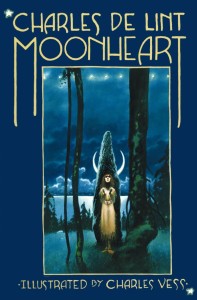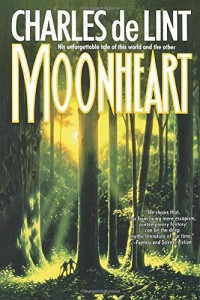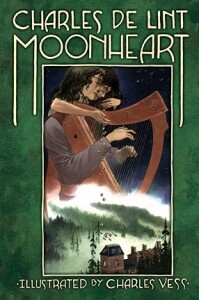 Moonheart may very well be the first novel by Charles de Lint that I ever read. I can’t really say for sure — it’s been awhile. It certainly is one that I reread periodically, a fixture on my “reread often” list. It contains, in an early form, all the magic that keeps us coming back to de Lint. (And be reminded that Charles de Lint may very well be the creator of what we call “urban fantasy” — he was certainly one of the first to combine contemporary life and the stuff of myth.)
Moonheart may very well be the first novel by Charles de Lint that I ever read. I can’t really say for sure — it’s been awhile. It certainly is one that I reread periodically, a fixture on my “reread often” list. It contains, in an early form, all the magic that keeps us coming back to de Lint. (And be reminded that Charles de Lint may very well be the creator of what we call “urban fantasy” — he was certainly one of the first to combine contemporary life and the stuff of myth.)
It’s a novel that is centered on a Place, a location that is a portal between worlds. In this case, Tamson House, the home of Jamie Tams and Sarah Kendell, among others, is a portal between the World Beyond — our world — and the Otherworlds, those places inhabited by the spirits and seers and shamans of both the Native traditions and the folklore of the European immigrants. The story is about an ancient evil that has bided its time and is now ready to strike. It is an evil born in ancient Gwynedd, the result of a curse by the bard Taliesin when he was cast adrift in exile. Thomas Hengwr, a sage and wizard, has been training Kieran Foy as his apprentice to help in the fight against the evil, which he believes is Taliesin gone bad. Kieran and Sarah are cast into the Otherworlds by the  quin’on’a, Native spirits. Sarah, having accidentally traveled through time, meets Taliesin. In the meantime, Mal’ek’a, The Evil That Walks Nameless, has attacked Tamson House.
quin’on’a, Native spirits. Sarah, having accidentally traveled through time, meets Taliesin. In the meantime, Mal’ek’a, The Evil That Walks Nameless, has attacked Tamson House.
There are layers to this story, and many characters who have roles to play. And there are enough heroes to go around: Kieran, who fights against hopeless odds to prove not only his worth but his honesty; Sarah, who has the courage to face the dark parts of her soul, although it nearly destroys her; the ex-biker Blue, resident and self-appointed security chief of Tamson House, who will go all out to defend those in his care; Jamie, who will sacrifice everything for those he loves. These are not Superman-type heroes, just regular people caught up in events sometimes beyond their understanding, but needing everything they’ve got to survive.
Moonheart was my first experience with de Lint’s own idiosyncratic — well, call it cosmogony, because it might as well be, a mythic structure of Native spirits, ancient Celtic gods and faerie (and I do mean ancient — we’re talking Cernunnos here, the Horned God  found from the British Isles to India, none of your latecomers like Queen Mab). De Lint characterizes his writing as “mythic fiction” and that really makes a lot of sense. He’s done nothing so shallow as to incorporate fairies and elves as characters and let it go at that. He reaches back to the meanings of those kinds of characters and comes up with a new synthesis, a layered universe in which certain beings travel back and forth and have an impact far out of proportion to their actual deeds. Plop these kinds of meanings down in and around the world of contemporary Ottawa and you have a particularly rich context for an exposition on the Big Questions: de Lint’s ongoing theme is really “what is moral behavior?” His answer boils down to what I characterize as “community,” a sense that we belong to the world as the world belongs to us, and we are all responsible for each other: the great moral failure in de Lint’s universe is not caring.
found from the British Isles to India, none of your latecomers like Queen Mab). De Lint characterizes his writing as “mythic fiction” and that really makes a lot of sense. He’s done nothing so shallow as to incorporate fairies and elves as characters and let it go at that. He reaches back to the meanings of those kinds of characters and comes up with a new synthesis, a layered universe in which certain beings travel back and forth and have an impact far out of proportion to their actual deeds. Plop these kinds of meanings down in and around the world of contemporary Ottawa and you have a particularly rich context for an exposition on the Big Questions: de Lint’s ongoing theme is really “what is moral behavior?” His answer boils down to what I characterize as “community,” a sense that we belong to the world as the world belongs to us, and we are all responsible for each other: the great moral failure in de Lint’s universe is not caring.
And he does it with compelling stories told with the gifts of a bard. Sure, he can be “talky,” he carries a bit of a soapbox around with him, but he makes you want to listen, and, to paraphrase Henry Kuttner, if you want to get your message across, you have to make people want to listen.
Moonheart may not be as polished or as seamless as later works, especially the Newford stories, but it brings the message through loud and clear.
You can find the Triskell Press digital edition here.
(Ace Books, 1984)
